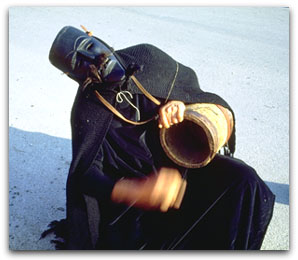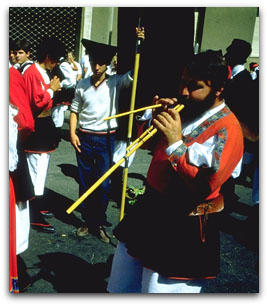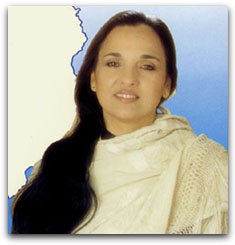
 Su tunchiu (si tratta
di uno strumento il cui suono fà imbizzarrire i cavalli) Su tunchiu (si tratta
di uno strumento il cui suono fà imbizzarrire i cavalli) |
|
The "muttos" of the area
Logudorese-Barbaricina and the "muttetus" typical of the Campidano are probably the
most widespread type of songs. They generally have a love or satirical theme, are
adaptable to every occasion and can be performed in different ways. They are also
widely used for the Sardinian tarantism that can be seen in the rites of the "argia" (a
kind of spider) which are performed to heal people bit by the spider.
Typical of some specific areas are the "gobbule" Christmas offering songs
from Sassari; the "curba", satirical songs from the Campidano; the "Corsicane",
from Gallura and widely spread also in Logudoro.
|
The "Corsicane" are so
called because they are thought to be of Corsican origin.
They have a nostalgic tune and a love theme. Signs of Catalan influence can be
found in Alghero, where there are the "cobles". Within the POLYVOCALITY we must
not forget the many musical pieces made famous by choral groups, such as "Adios
Nugoro amada" by the canon Antonio Giuseppe Solinas, a song which became the
hymn of those Sardinian people who were forced to leave their land; "Nanneddu meu"
by Peppino Mereu; the exquisite love song "No potho reposare" written by Salvatore
Sini and set to music by M.Rachel in 1921; the melancholic and popular "In su monte
e Gonare" and "Deus ti salvet Maria" the Hail Mary which is perhaps the most famous
song in the Sardinian language.
|
|

 Peppe Cuga Peppe Cuga |

 Maria Carta Maria Carta |
|
Some of these pieces have been made famous
throughout the world by Maria Carta, probably the most representative singer in the Sardinian tradition.
Born in Siligo, near Sassari, she died in Rome about two years ago. Nowadays a great number of these songs
and the various styles of Sardinian music are being revisited in a vein of modern and respectful contamination,
with the use of traditional instruments and modern electrical ones which are not part of the Sardinian
heritage.
|
|